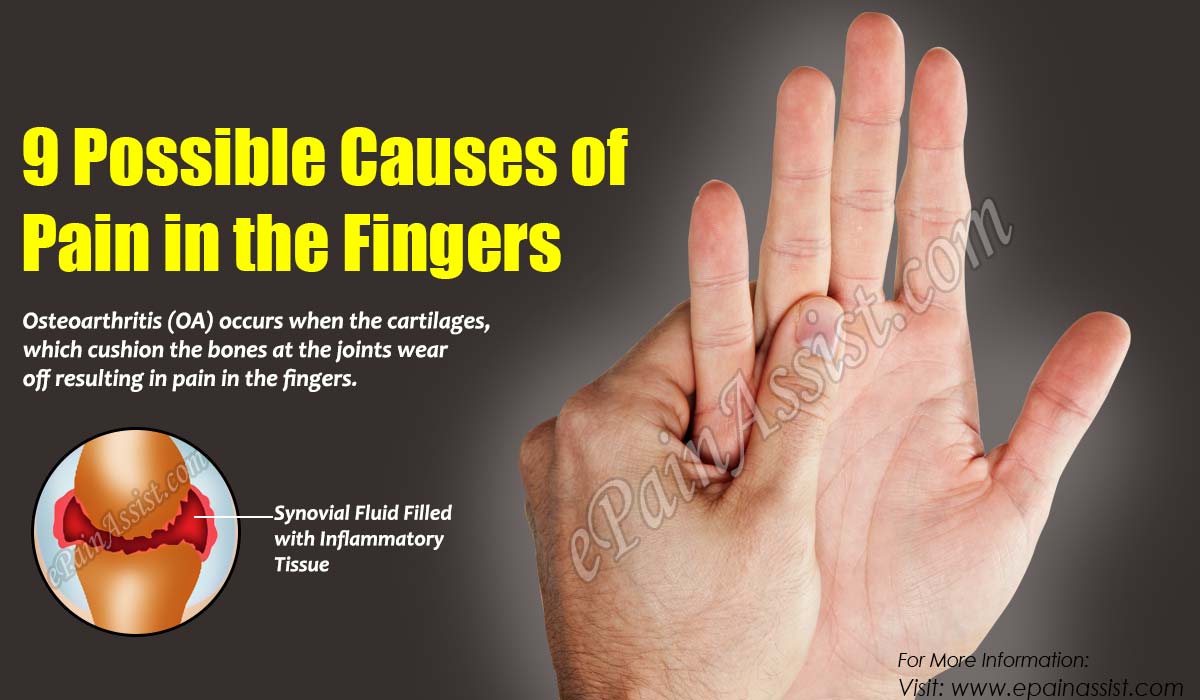Finger pain is a cramp-like, throbbing or achy pain felt in the fingers, including the thumb. A hand injury is one of the most common causes of pain in the fingers.1 Injuries to the finger can cause an open cut, tissue and muscle damage, or a fractured or bruised bone. Common injuries which trigger pain in the fingers are broken finger nails, cuts and broken finger caused by jamming of the fingers while lifting something heavy improperly. Are you experiencing pain in the fingers? These could be the possible reasons.

9 Possible Causes of Pain in the Fingers
Certain medical conditions which affect the muscles, nerves, or bones can cause pain in the fingers. Some of the possible reasons responsible for finger pain include:
#1. Carpal Tunnel Syndrome: In this condition, the median nerve located in the palm gets compressed as it passes into the hand and causes pain in the fingers.2
#2. Osteoarthritis: Osteoarthritis (OA) occurs when the cartilages, which cushion the bones at the joints wear off resulting in pain in the fingers.
#3. Rheumatoid Arthritis (RA): RA is an autoimmune disease which triggers joint pain and damage throughout the body, especially in the hands and the legs and is a possible cause for pain in the fingers.
#4. Osteoporosis: Osteoporosis is a skeletal disease in which the patient suffers from a loss of bone density which increases their risk of fractures. Pain in the fingers can also be experienced due to osteoporosis.
#5. Raynaud’s Phenomenon: The condition of Raynaud’s phenomenon occurs when the blood vessels in the feet and hands get constricted and interrupt the normal flow of blood to the toes, fingers, nose or ears. Such episodes of constriction are known as vasospasms. Raynaud’s phenomenon is also one of the possible reasons for pain in the fingers.3
#6. Systemic Sclerosis (Scleroderma): This is a chronic connective tissue disorder, which is a type of autoimmune rheumatic disease. Scleroderma is a possible cause for having pain in the fingers.
#7. Juvenile Idiopathic Arthritis: This is a common form of arthritis which mostly affects children and cause finger pain along with pain in other joints.
#8. Leprosy: Leprosy is a progressive and chronic bacterial infection which causes disfigurement and disability if not treated in time. Pain in the fingers can occur in leprosy also.
#9. Other causes of pain in fingers are muscular dystrophy, tumors, multiple sclerosis, nodules, boils and cysts. Compression or pinching of nerve in the hand, arm or wrist can also result in thumb or finger pain.
How to Identify the Type of Finger Pain
Finger pain can either be dull and achy, or sharp and cramp-like. The pain can begin suddenly and then fade away, gradually. If the finger is broken, it usually becomes bluish-purple in color, swollen and extremely painful. At times, the bone may even get physically separated and may become visible through the skin. A finger dislocation happens when the bones of the thumb or finger get dislocated from their joints. The sufferer can also experience a sharp shooting or throbbing pain.
Carpal tunnel syndrome and other medical conditions which affect the muscles and nerves in the hand and arm can cause throbbing pain in the fingers and hands. This type of finger pain occurs when the fingers or wrist are moved. Tremors in the hand and difficulty in typing or writing is also experienced by individuals suffering from these health conditions. A cut on the finger may result in pain at the injury site. Depending on the depth of the cut, one may experience pain which radiates to the surrounding areas of the hand. In case of an extra growth on the hand like a nodule or a boil, along with the pain in the fingers, the sufferer may also experience a tender and fluid filled lump or a movable lump present beneath an area of hardened skin.
Diagnoses & Treatment for Pain in the Fingers
In case of cut or growth on a finger, the doctor would examine the patient physically to diagnose the condition. The doctor may also order for certain blood tests and imaging tests like x-ray, MRI etc. to look for any nerve damage. The patient may also need to inform their doctor about the medications they are taking, their medical history, and their occupation to find the exact root cause of the pain in the fingers.
Finger pain caused by scrapes, cuts or burns generally heal in time without any treatment. Over-the-counter pain medications can be used to ease the discomfort. However, in case of deep cuts, bruises and extensive burns caused by fractures, proper treatment would be needed to cure the condition. Some patients may also need to undergo a surgery to deal with these problems. The doctor may prescribe pain medications to treat pain in the fingers caused by tissue, nerve or muscle damage. Patients may also need to resort to other treatments like hand exercises and use of special gear-like splints to ensure complete relief from the pain in the fingers.
Finger pain can disturb your life to a great extent. Not only can this pain make it difficult for you to work efficiently at your job and carry on your daily chores, normally, but it can also make it tougher for you to enjoy certain leisure activities. Stop bearing this pain in silence and consult your doctor before your finger pain worsens.
Also Read:
- Home Remedies for Arthritis in Hands
- Broken Finger or Fractured Finger: Causes, Signs, Symptoms, Treatment
- Sprained Finger or Finger Sprain: Types, Causes, Signs, Symptoms, Treatment, Exercises
- Knuckle Pain & Swelling: Causes, Treatment, Home Remedies
- What Causes Radiating Pain to Pinky Finger & How is it Treated?
